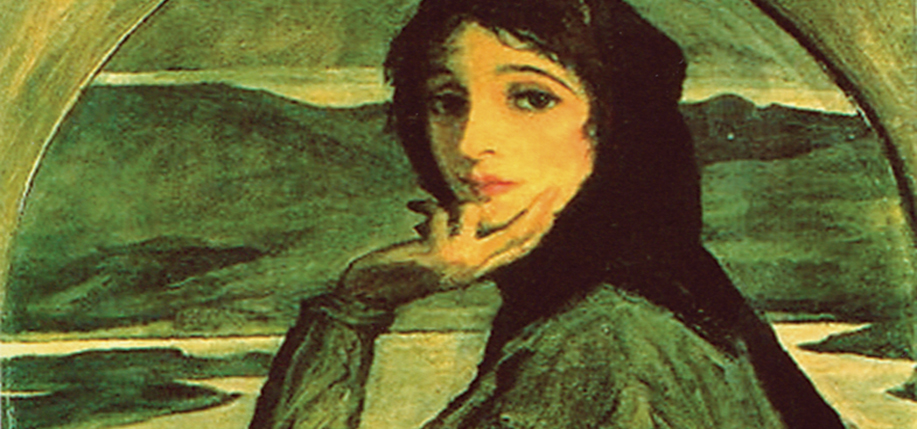Reflections on Queen Elizabeth’s historic trip to Ireland.
The recent four-day visit of Queen Elizabeth II to Ireland – the first by a reigning monarch in a hundred years – was a stunning triumph, capped by the five-minute standing ovation she received at a musical performance on her final night in the Irish capital. That performance included excerpts from Riverdance, which the Queen appeared to hugely enjoy. Bill Whelan, the composer of Riverdance, was also commissioned to write a march for an Irish military band for the arrival of the Queen at Dublin Airport. The title of this piece, “The Walk of a Queen,” carried a hidden meaning, for it was taken from the famous closing line to Yeats’s revolutionary play, Cathleen ni Houlihan, first produced in 1902.
In the play, the mythic figure of Cathleen ni Houlihan functions, in the eighteenth-century Irish tradition of the aisling, or dream poem, as a symbol of national pride and fierce resistance to British rule. Yeats portrayed Cathleen as an old woman who persuades a young man on the eve of his wedding to serve her cause by joining in the 1798 Rebellion, which ended in a massacre of the vastly overmatched Irish rebels. Following the exit of the young man at the end of the play, his father turns to his last remaining son, a boy of twelve, and asks him if he has seen “an old woman passing by.” “I did not,” says the boy, “but I saw a young girl and she had the walk of a queen.”
In the first performance of Cathleen ni Houlihan, the play’s patriotic theme was reinforced when the title role was performed by Maud Gonne, one of the great beauties of the time, the great love of Yeats’ life and a revolutionary leader in her own right. As interpreted by Gonne, the play became a clarion call to arms directed at prospective rebels. Seen through the eyes of a young boy, however, the queen evokes a prophetic vision of an Ireland completely transformed and filled with the radiance of ever youthful possibility.
This prophecy was partly fulfilled in the 1916 Easter Rising and subsequent War of Independence that brought a partial end to British rule in Ireland. The treaty signed in 1922 between England and Ireland contained two clauses with extremely vexing aftereffects: the first retained the Crown as the titular head of the newly created Irish Free State, while the second established Northern Ireland as a semi-autonomous state for those mainly Protestant loyalists who preferred to remain part of the United Kingdom.
Like me, Bill Whelan is the son of an IRA man who fought in the Irish Revolution. When Whelan wrote the music for a production of Cathleen ni Houlihan that I directed at the 1991 Yeats Festival at the Abbey Theatre, the National Theatre of Ireland, we shared many stories about the heroic ideals of our fathers. However, we both agreed that the legacy of the Irish Revolution was fraught with many unresolved conflicts. Indeed, that was tragically all too evident in the bloody warfare that continued to sow hatred and distrust among the people of Northern Ireland as well as between Irish nationalists throughout the island and the British government. That time of horror only ceased with the Good Friday Agreement of 1998 that at last brought peace to Northern Ireland and the beginnings of reconciliation among all the people on the island.
Bill Whelan and I came to recognize that, in hindsight, Cathleen ni Houlihan is a far more ambiguous play than appeared at the time of its first production. The young warrior in the play is, after all, going out the door of his peasant cottage to kill and be killed. In our production at the Abbey Theatre, Whelan’s score was suffused with the harsh sounds of gunfire, bombs and the cries of the wounded and dying. This was intended to reinforce the brutal realities of violent revolution, however admirable and necessary the ultimate goals of those in revolt.
I’m glad to say that the production did not kill the romantic idealism of the play nor its fealty to the memory of those who were prepared to lay down their lives for the cause of freedom. But neither did it fail to bring out the terrible cost of warfare on the men who fight, their families and fellow countrymen as well as those on the other side of the conflict. A special lesson for our own time in the historic British-Irish conflict is that terrorism exercised with moral indifference carries lasting consequences that are always extraordinarily difficult to acknowledge, much less redress.
The visit of Queen Elizabeth in Ireland represents a kind of coming of age for the Irish Republic – now a sovereign nation extending the hand of friendship to the head of what was once a hated oppressor. The sight of the Queen of England reverently bowing her head at the Garden of Remembrance, a memorial in central Dublin intended to honor Irish rebels who died fighting to free Ireland from British conquest, was an incredibly moving moment. But was it only the Irish fallen heroes that she was commemorating? The ambiguity of her gesture makes it all the more noble as a sign of reconciliation and healing. I’m sure that in a nation that cherishes the role of culture in shaping its identity as much as Ireland does, many Irish caught the hidden meaning in the title of Bill Whelan’s musical homage to the two queens present throughout the Monarch’s visit. Without intending any disrespect to Her Royal Majesty and the importance of her state visit, it is good to know that, in the tradition of the aisling, having an inward smile of recognition is a far better sign of independence than veiled threats, weapons or protracted enmity.


Leave a Reply